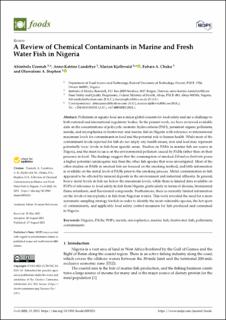| dc.description.abstract | Pollutants in aquatic food are a major global concern for food safety and are a challenge to both national and international regulatory bodies. In the present work, we have reviewed available data on the concentrations of polycyclic aromatic hydrocarbons (PAH), persistent organic pollutants, metals, and microplastics in freshwater and marine fish in Nigeria with reference to international maximum levels for contaminants in food and the potential risk to human health. While most of the contaminant levels reported for fish do not imply any health issues, iron and lead may represent potentially toxic levels in fish from specific areas. Studies on PAHs in marine fish are scarce in Nigeria, and the main focus is on the environmental pollution caused by PAHs rather than on their presence in food. The findings suggest that the consumption of smoked Ethmalosa fimbriata poses a higher potential carcinogenic risk than the other fish species that were investigated. Most of the other studies on PAHs in smoked fish are focused on the smoking method, and little information is available on the initial level of PAHs prior to the smoking process. Metal contamination in fish appeared to be affected by mineral deposits in the environment and industrial effluents. In general, heavy metal levels in fish are below the maximum levels, while there is limited data available on POPs of relevance to food safety in fish from Nigeria, particularly in terms of dioxins, brominated flame retardants, and fluorinated compounds. Furthermore, there is currently limited information on the levels of microplastics in fish from Nigerian waters. This work revealed the need for a more systematic sampling strategy for fish in order to identify the most vulnerable species, the hot spots of contaminants, and applicable food safety control measures for fish produced and consumed in Nigeria. | en_US |
